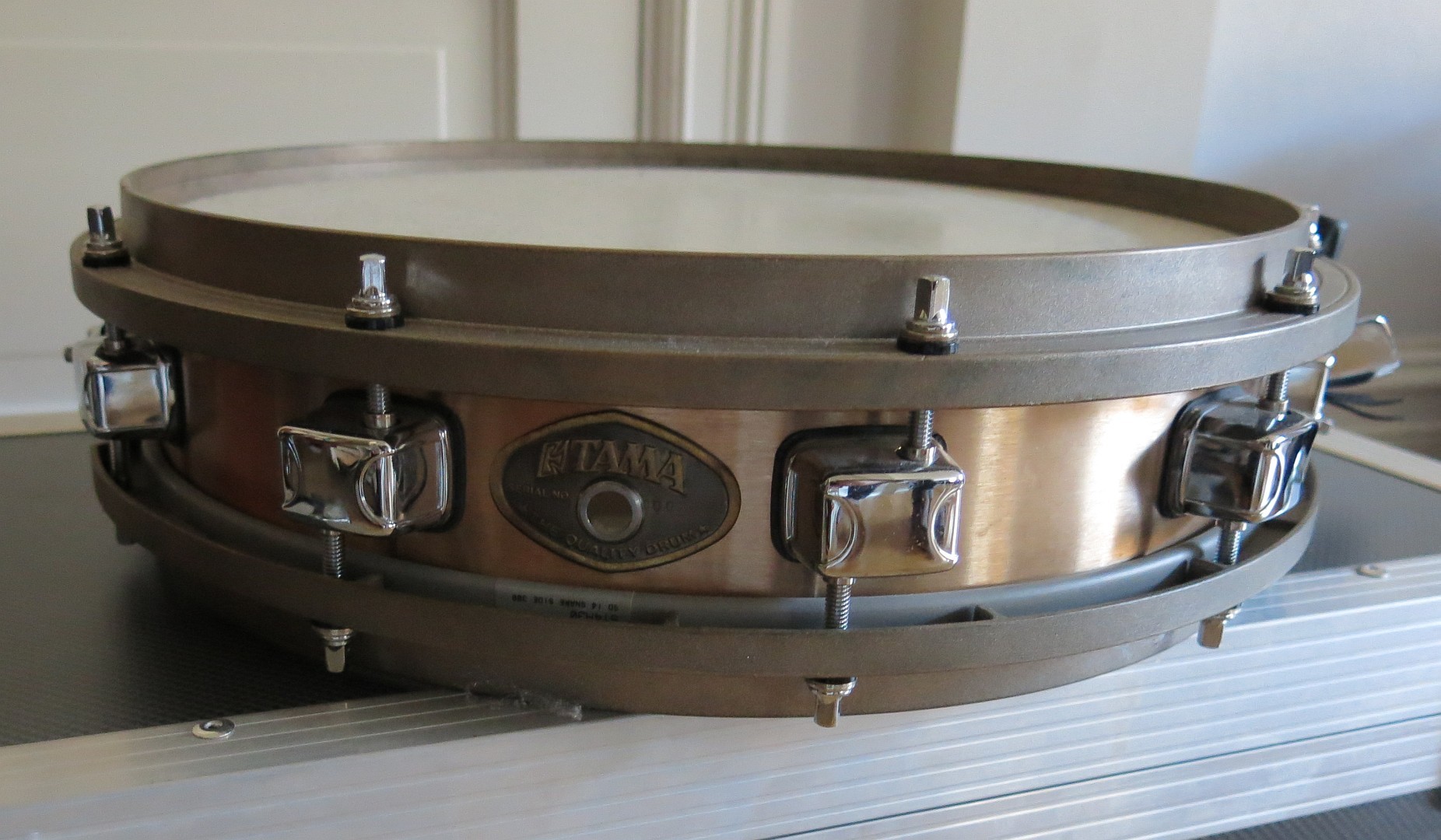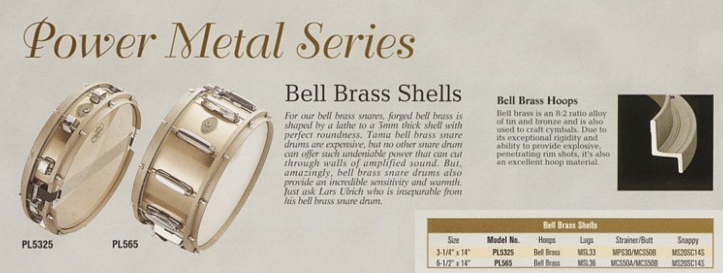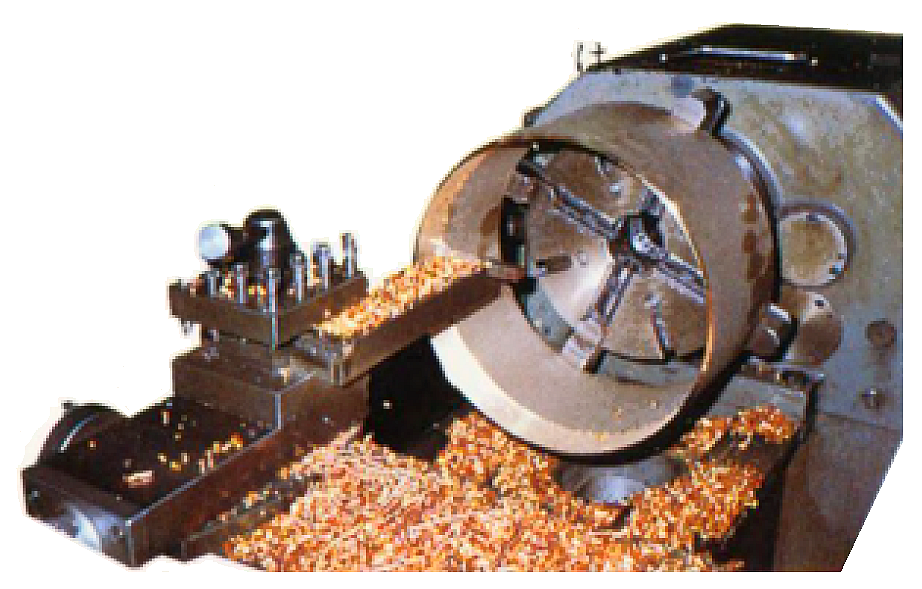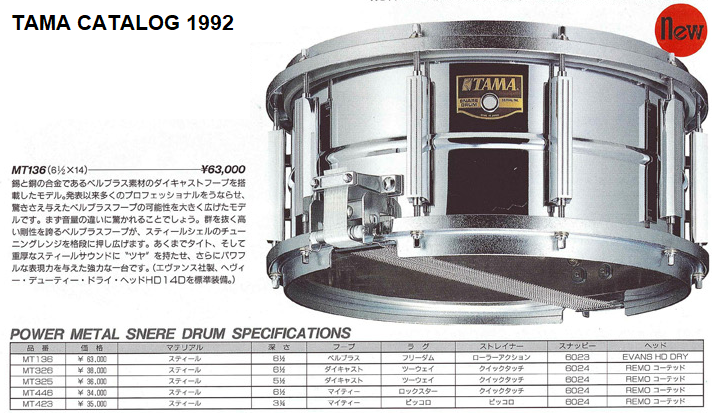
bellbrass/Tama_Snare_PL5325a.jpg
To view high resolution images, right click on image and select View image or Save image

Now what makes a snare drum so unique that drummers and studio owners where willing to pay 4000USD, with some even peaking as high as 7500USD on auctions before the BB156 reissue where released? The sound of course.
Sadly the way they got to this sound are very costly and laborious with need of special skills where a seamless shell are first casted and forged from bell bronze alloy. Also called B20 bronze, a 4:1 ratio of copper to tin (typically, 78% copper, 22% tin by mass), similar stuff used to make cymbals.

After forging drum shell are then lathed to correct dimensions. There are a lot of inconsistency found trying to piece this information together. One reason can be that Tama seems to have differentiate the world marked and even used different model names for some of the BB snares.
The most popular story are that early Tama models in the 80’s where lathed to 5 mm thickness. According to a english flyer from 1982 it sayes the 12 mm casting are lathed to 3 mm. The japanese catalogs archive has 1982 as the first year the BB156 appears. On drumarchive.com we find an english flyer claiming to be from 1980. This flyer list BB155 and BB156 with 5 mm shells. Interstingly the 5"x14" BB155 are never listed in any of the japanese catalogs, nor does it appear in later english catalogs.
When new these drums where understandable very expensive, — as they are now. And sales weren’t that high, which makes them rather sparse in the used marked despite being in production for two decades.
All videos are borrowed content from YouTube
Bell brass is an 8:2 alloy of tin and bronze and is also used to craft cymbals. Due to its exceptional rigidity and ability to provide explosive, penetrating rim shots, it’s also an excellent hoop material. Tama flyer

Spending time on drum forums one get the notion that near all snare drums made from seamless casted metal and lathe holds some kind of magic to them, independent of brand or maker.
Interestingly Tama took the concept using B20 bronze alloy one step further and according to their catalog achieve they introduced the MBH14 bell brass hoops in 1989 with the BB346 6½”x14” and BB343 3¼”x14” snares.
Compared to other die cast hoops one notice MBH14 are not shaped to contour around the tuning bolt. This of course simplify any machining after casting. But one can speculate if this uniform circular design together with the hoops rigidness also helps controlling ringing. Despite their fugly looks MBH14 brings incredible warmth to the drum sound.

In the catalog for 1992 Tama list new for the year MT136, a high end steel snare. Pictures show a drum with hoops that looks like they are molded width the same mold as MBH14 with aluminum or some other alloy. Not been able to find this drum in any english flyers and being a poor reader in japanese one might speculate that this can actually be genuine bell brass hoops with silver paint.
Over the two decades Tama had these BB snares in production they mostly changed the lugs and strainers to comply with that years fashion. The two fundamental changes where the shell thickness and MBH14 hoops.
Some FUD (fear, uncertainty and doubt) can be read about the two way offset lugs used from 1994-1999. Not sure as to this FUD being based on real experience from Tama piccolo drums from the time period or not? My PL5325 with second generation offset lugs has shown no signs of problems. And honestly I’m not sure if I agree with claims saying the lug can twist due to different tension on top and bottom head. If rims are put on correctly mounting holes for the lug are placed in-line with the corresponding lug tuning nut. Meaning all pull force will go to this single assembly point, just as they do with the MTL23 piccolo single lug used on earlier models.
Using Tama’s Japanese catalog archive this is how the story evolved with focus on the piccolos
http://www.tamadrum.co.jp/anniversary_j/
| 1980 | BB not listed in Japanese archive, but English catalog claimed to be from this year list BB155 5" and BB156 6½” with 5 mm shells. |
|---|---|
| 1982 | The first bell brass snare are listed for the Japanese marked with the BB156 6½” using PC die cast iron hoops. English flyer now says drum shell are 3 mm. |
| 1988 | Modell name changed to BB256 6½”, still with iron hoops. Please see 1989 for English marked. |
| 1989 | First year the catalog list a BB piccolo. More importantly this is the year MBH14 bell brass hoops are introduced with the BB346 6½” and BB343 3¼”. English catalog from 1988 list them as PM426 and PM423 (power metal). |
| 1992 | BB116 6½”, BB123 3¼” seems to be the last model using the single MTL23 Piccolo Lug. Similar lugs are later seen on some metal snares with 11 lugs though. |
| 1994 | BB126 6½”, BB173 3¼” piccolo now has two way offset lugs. |
| 1996 | PL565 6½”, PL5325 3¼” new cosmetic design on lugs for all models. |
| 1999 | Changed to inline two way lugs for the PL5325N. PL565 6½” unchanged. |
| 2003 | PL540N 4", PL555N 5½” and PL565N 6½”. 3¼” depth increased to 4”. First 5½” BB introduced. |
| 2004 | Seems to be the last year the PL bell brass series with MBH14 bell brass hoops where produced. |
| 2005 | SLS1440H 4", SLS1455H 5½” and SLS1465H 6½”. SLS14xxH series are indisputable the most gorgeous looking of the bell brass series, but gone are the unique MBH14 die cast bell brass hoops. |

bellbrass/Tama_Snare_PL5325a.jpg
To view high resolution images, right click on image and select View image or Save image
Select file from list below
Your comment are welcome